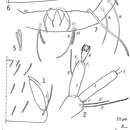en
names in breadcrumbs


Pauropoda is one of the four major clades of Myriapoda (Myriapoda = Chilopoda [centipedes] + Diplopoda [millipedes] + Symphala [symphylids] + Pauropoda [pauropods]) (Rehm et al. 2014 and references therein). The centipedes, the only predatory myriapods, include around 5000 known species. The millipedes, which have two pairs of legs per segment, include around 12000 species. Pauropods and symphylids are small, translucent, soil-dwelling "micro-myriapods", with body lengths of less than 2 mm and 1 to 8 mm, respectively. The symphylids have long and filiform antennae and a pair of specialized appendages at the preanal segment known as spinnerets. The pauropods have distinctive antennae, which are branching and have long flagella. Around 800 pauropod species and around 200 symphylid species have been described (Scheller 2008; Minelli (2011).
Pauropods have the gonopore (sexual opening) between the bases of the 2nd pair of legs. The antennae have a 4- or 6-segmented stalk and are bifurcated distally. One antennal branch has two flagella, which flank a sense organ, known as the globulus, which resembles a ball in a spiny cup; the other branch bears a single flagellum.Adult pauropods have a 12-segmented abdomen and 8 to 11 pairs of legs with 5 to 6 segments. (Scheller 2008; lucidcentral.org)
Scheller (2008) proposed a classification of the Pauropoda that includes two orders, 9 families, 40 genera, and about 780 species. For each genus, Scheller gives the geographic distribution andnumber of known species. According to Minelli (2011), Pauropoda includes 12 families, 46 genera and 835 described species.
A range of studies have inferred various different phylogenetic relationships among the four major myriapod groups. Dong et al. (2012) obtained the first complete mitochondrial genome sequence from a pauropod and, combining this in a phylogenetic analysis that included complete mitochondrial sequences from other myriapods, concluded that Pauropoda and Symphyla are sister groups. Miyazawa et al. (2014) reviewed various proposals, but based on their own molecular phylogenetic analysis they concluded that the symphylids are sister to the other three myriapod groups. This finding is consistent with the results of Rehm et al. (2014).